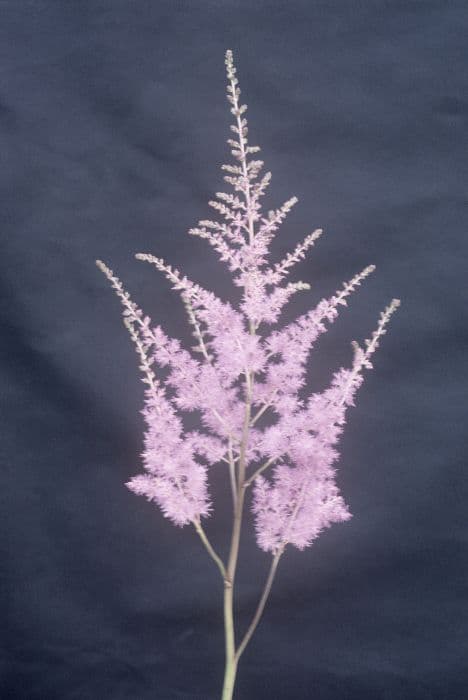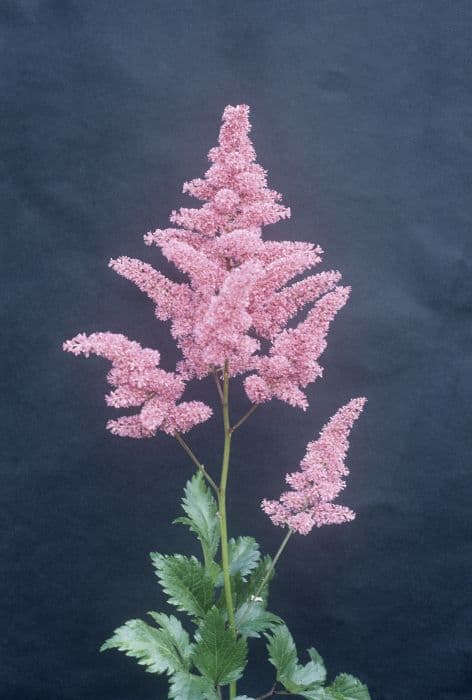Strawberry Begonia Saxifraga 'Kinki Purple' (stolonifera) (5)

ABOUT
Saxifraga 'Kinki Purple', also known as the strawberry begonia, is a visually distinctive plant that is favored for its ornamental qualities. This plant typically features a rosette of rounded, textured leaves. The foliage is rich and velvety, often with a deep green hue that can present a purple undertone, lending it the 'Kinki Purple' distinction. Along the edges of the leaves, one may notice a fine, silvery veining that adds to the plant's charm. In addition to its foliage, the strawberry begonia is known for producing slender, long stems which bear small clusters of delicate white flowers. These blooms typically have a subtle blush of pink which complements the darker tones of the leaves. The stems, or stolons, also give rise to new plantlets that dangle at their ends, creating a charming cascading effect that is particularly appreciated when the plant is placed in a hanging basket or elevated position. The combination of its attractive leaf coloration, silver veining, and dainty flowers provides a stunning visual display that makes the strawberry begonia a popular choice for gardeners and houseplant enthusiasts alike.
About this plant
 Names
NamesFamily
Saxifragaceae.
Synonyms
Kinki Purple Saxifrage, Purple Saxifrage, Purple Mother of Thousands, Purple Beard Saxifrage, Kinki Purple Strawberry Begonia, Creeping Saxifrage.
Common names
Saxifraga 'Kinki Purple' (stolonifera).
 Toxicity
ToxicityTo humans
The Mother of Thousands is not considered toxic to humans. However, as with any plant, individual sensitivities can vary, and it's generally a good idea to avoid ingesting parts of ornamental plants. If a person is concerned about potential poisoning, they should consult with a medical professional.
To pets
The Mother of Thousands is not known to be toxic to pets. Still, it's always best to prevent pets from eating plants as a precaution, since digestive upset or allergic reactions may occur from substances that are not necessarily classified as poisons. If a pet appears to be suffering from symptoms of poisoning after ingesting part of the plant, it is recommended to contact a veterinarian.
 Characteristics
CharacteristicsLife cycle
Perennials
Foliage type
Evergreen
Color of leaves
Green
Flower color
Pink
Height
6 inches (15 cm)
Spread
1 foot (30 cm)
Plant type
Herb
Hardiness zones
7
Native area
Asia
Benefits
 General Benefits
General Benefits- Easy Maintenance: Saxifraga stolonifera is known for being a low-maintenance plant that doesn't require frequent watering or complex care routines, making it perfect for beginner gardeners or those with busy schedules.
- Ground Cover: With its spreading habit, it can effectively cover ground, reducing weed growth and soil erosion.
- Attractive Foliage: The plant has striking leaves that are often variegated or have interesting patterns, adding aesthetic value to the garden.
- Tolerance to Shade: It can thrive in shady areas where other plants might struggle, making it a good choice for darker parts of the garden.
- Seasonal Flowers: Saxifraga stolonifera produces delicate flowers that add seasonal interest and beauty to the gardening space.
 Medical Properties
Medical PropertiesThis plant is not used for medical purposes.
 Air-purifying Qualities
Air-purifying QualitiesThis plant is not specifically known for air purifying qualities.
 Other Uses
Other Uses- Saxifraga 'Kinki Purple' can be used as a natural dye source for fabrics, providing a range of hues depending on the mordant used.
- The plant's delicate flowers are sometimes used in the confectionery industry as an edible decoration for desserts and sweets.
- In artistic applications, its leaves and flowers can be pressed and included in botanical artworks or herbarium collections.
- Enthusiasts of miniature gardens or fairy gardens often use Saxifraga to create a sense of scale and add unique textures to their designs.
- As a naturally compact plant, it serves as a living mulch, suppressing weeds and helping to retain soil moisture.
- The Saxifraga can be used as a model organism for educational purposes, demonstrating plant growth and reproductive patterns in botany classes.
- Its textured foliage and cascading growth habit make it an intriguing subject for macro photography, providing detailed and close-up shots of its morphology.
- Inscaping, the practice of creating indoor landscapes, can incorporate Saxifraga for its color and form, complementing modern and rustic decor setups.
- The plant can be employed in sensory gardens for its varied textures, helping to stimulate touch and sight for a therapeutic experience.
- Survivalists may use the Saxifraga for learning primitive fire-starting techniques; while not a common use, the dried stems could act as tinder for sparking a flame.
Interesting Facts
 Feng Shui
Feng ShuiThe Saxifrage is not used in Feng Shui practice.
 Zodiac Sign Compitability
Zodiac Sign CompitabilityThe Saxifrage is not used in astrology practice.
 Plant Symbolism
Plant Symbolism- Tenacity: The Saxifraga, belonging to a genus whose name means "stone-breaker," often symbolizes tenacity and the ability to persevere as it is known for growing in cracks in the rocks and thriving in hardy conditions.
- Endurance: Given its capacity to survive in rocky terrains and its stoloniferous growth habit, the 'Kinki Purple' variety exemplifies endurance, demonstrating how life can persist in challenging environments.
- Protection: The Saxifraga's thick leaves often appear to form a protective mat over the soil, thus symbolizing a natural blanket of protection over more vulnerable life forms.
- Affection: In some cultures, the Saxifraga is given as a token of sincere love and affection, where its persistence to grow is equated with persistent affection.
- Purity: The delicate and often light-colored blooms of the Saxifraga plants can represent purity and innocence, making it a suitable gift for conveying a message of pure intent.
 Water
WaterThe Strawberry Begonia requires a good balance of moisture, so it's best to water it thoroughly when the top inch of the soil feels dry to the touch, which may vary from once a week to every other week, depending on the environmental conditions. Use room temperature water and avoid wetting the foliage directly to prevent disease. For a pot of around 6 inches in diameter, you can start by using around 8 to 16 ounces of water and adjust the amount based on the plant's response over time. During the winter months, reduce the frequency of watering as the plant goes into a dormant period.
 Light
LightStrawberry Begonia performs best in bright, indirect light. An ideal location would be a spot where it can receive filtered sunlight, such as near an east-facing window where the morning sunlight is gentle, or a north-facing window. Direct afternoon sunlight should be avoided as it can scorch the delicate leaves of the plant.
 Temperature
TemperatureStrawberry Begonia prefers temperatures between 60 and 75 degrees Fahrenheit for optimal growth. It can tolerate minimum temperatures down to about 40 degrees Fahrenheit and should be protected from frost. Make sure to place it in a location where it's not exposed to cold drafts or heat vents that can cause extreme temperature fluctuations.
 Pruning
PruningPruning Strawberry Begonia is mainly done for aesthetic reasons and to remove any dead or yellowing leaves to maintain the plant's health and appearance. The best time to prune is in the spring when the plant begins its active growth cycle. Prune sparingly and focus on deadheading spent flowers and trimming back leggy stolons to encourage bushier growth. Pruning every few months will keep your plant looking its best.
 Cleaning
CleaningAs needed
 Soil
SoilStrawberry Begonia flourishes in well-draining, rich soil with a pH range of 5.5 to 7.0. A mix of peat, perlite, and potting soil in equal parts is ideal for potting.
 Repotting
RepottingStrawberry Begonia should be repotted every 2 years to refresh the soil and accommodate root growth.
 Humidity & Misting
Humidity & MistingStrawberry Begonia prefers high humidity levels around 60-70% for optimal growth.
 Suitable locations
Suitable locationsIndoor
Place Strawberry Begonia in bright, indirect light and high humidity.
Outdoor
Grow Strawberry Begonia in shaded areas with moist soil.
Hardiness zone
6-9 USDA.
 Life cycle
Life cycleThe life cycle of Saxifraga stolonifera, commonly known as Strawberry Begonia or Creeping Saxifrage, begins with seed germination, which occurs in a moist, well-draining environment, often in the spring. Following germination, the plant emerges as a seedling and soon develops into a mat-forming perennial with heart-shaped leaves and distinctive silvery markings. The plant spreads via runners, or stolons, which stretch outward from the central rosette and take root at their tips to produce new plantlets. During late spring to early summer, Strawberry Begonia produces loose panicles of small, white flowers with distinctive pointed petals and bright yellow centers, held above the foliage on slender, red-tinged stems. After flowering, the plant may produce small capsule fruits that contain seeds, completing the reproductive cycle. Throughout the year, but especially after flowering, gardeners often propagate Strawberry Begonia by separating and replanting the plantlets formed on the stolons.
 Propogation
PropogationPropogation time
Spring-Early Summer
Saxifraga 'Kinki Purple', also commonly known as Japanese Saxifrage, is best propagated through division, a process ideally performed in late winter to early spring before new growth begins. To propagate by division, carefully lift the plant from the soil and gently separate the clumps into smaller pieces, ensuring each new section has a portion of the root system. After dividing, replant the sections promptly at the same soil depth they were originally growing, spacing them about 8 inches (approximately 20 centimeters) apart to allow for future growth. Water the newly planted divisions well to encourage the establishment in their new locations. This method is successful due to the plant's ability to quickly root and establish from divided clumps.









